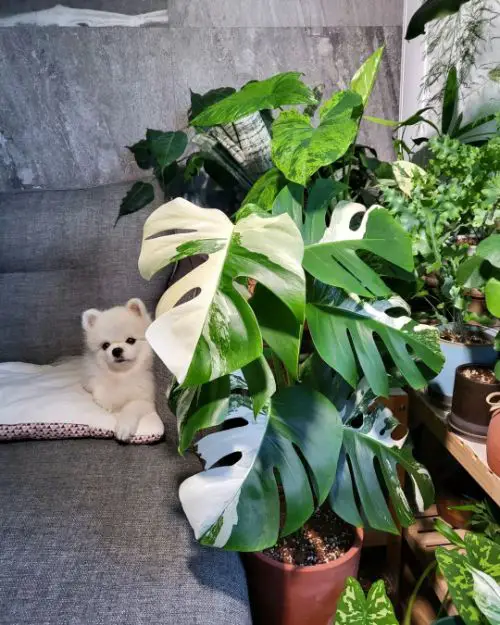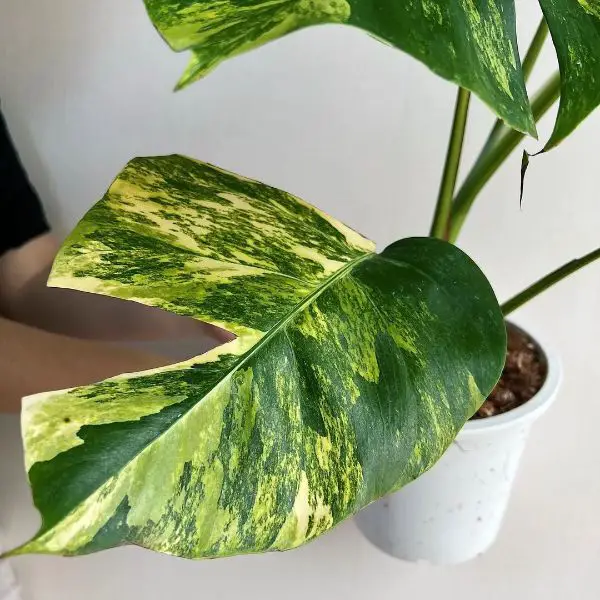Looking to add a Monstera Borsigiana to your home or garden? This guide will tell you everything you need to know about growing this beautiful plant, including care tips and advice on how to get it to grow.
What is monstera borsigiana?
Monstera Borsigiana is a sub-specie of Monstera Deliciosa, a genus of flowering plants in the family Araceae. In comparison to the Deliciosa, it is tiny and grows quickly. As the dark-green, heart-shaped leaves mature, they develop holes that eventually transform into the trademark Monstera perforations.
In order to create the stunning Variegated Monstera Borsigiana plant, the Borsiginia plant frequently undergoes variegation. These easy-care individuals require warmth and mild to bright indirect light. After the top layer of soil becomes dry, liberally water the area.
The plant is native to Central and South America and grows in rainforests as an epiphyte on trees. Monstera Borsigiana is a fast-growing evergreen vine that can reach up to 20 m in length. The plant has large, dark green leaves with Monstera-shaped holes. The flowers are white and borne on inflorescences up to 60 cm long.
Monstera Borsigiana is a popular houseplant and garden plant in many parts of the world. The plant is easy to care for and can be grown both indoors and outdoors. They are also known as the Swiss cheese plant, Mexican breadfruit, or Monstera deliciosa.
Where to Find Monstera Borsigiana?
You can find Monstera Borsigiana in tropical forests. It is a climbing plant that uses aerial roots to climb up trees. The leaves of this plant are very big and have unique markings on them. The flowers of this plant are small and white.
Where to buy Monstera Borsigiana?
There are a few places where you can buy Monstera Borsigiana. One option is to purchase it from a nursery or garden center. Another possibility is to order it online from a retailer that specializes in tropical plants. Finally, you might be able to find it at a local farmer’s market or plant fair.
No matter where you buy it, be sure to inspect the plant carefully before purchasing it. Make sure that the leaves are healthy and free of damage. Also, ask the seller how to properly care for the plant so that it will thrive in your home.

What is the difference between Monstera Deliciosa and Borsigiana?
Monstera Deliciosa and Borsigiana are two species of flowering plants in the family Araceae. Both plants are native to Central America, but they have some differences. Monstera Deliciosa is more commonly known as the Swiss cheese plant or split-leaf philodendron. It is a climbing vine that can grow up to 6 m (20 ft) tall. The leaves are large, up to 90 cm (35 in) long and 60 cm (24 in) wide, with deep lobes that give them a ruffled appearance. The flowers are white, borne on a spadix surrounded by a white spathe.
Borsigiana is a smaller plant, only growing to about 2 m (6.6 ft) tall. The leaves are much smaller, only about 20 cm (8 in) long and 10 cm (4 in) wide. They are also less deeply lobed than those of Monstera deliciosa. The flowers are greenish-white, borne on a spadix that is surrounded by a greenish-white spathe.
So, the main difference between Monstera Deliciosa and Borsigiana is their size, with Monstera Deliciosa being much larger. The leaves of Monstera Deliciosa are also much larger and more deeply lobed than those of Borsigiana. Finally, the flowers of Borsigiana are greenish-white, while those of Monstera Deliciosa is white.
Monstera Borsigiana Care
Monstera Borsigiana is a popular houseplant and garden plant in many parts of the world. The plant is easy to care for and can be grown both indoors and outdoors.
1. Potting and soil
When potting and soil Monstera Borsigiana, it is important to remember that this plant prefers well-drained soil. A good potting mix for this plant would be a mixture of peat moss, perlite, and sand.
The ratio of these ingredients can be adjusted depending on the needs of your particular plant. For example, if your plant is suffering from root rot, you may want to add more perlite to the mix. If your plant is experiencing a lot of drainage issues, you may want to add more sand.
2. Light
To ensure that your Monstera Borsigiana thrives, it is important to provide it with the right amount of light. This means finding a balance between too much light, which can scorch the leaves, and too little light, which can cause the plant to become etiolated (stretched out and leggy). The best light for Monstera Borsigiana is bright, indirect light.
To provide your plant with the right amount of light, you will need to experiment a bit to find the perfect spot in your home. Start by placing your plant in an area that receives bright, indirect light and observe how it does over the course of a few days.
If the plant seems to be doing well, then you have found the ideal spot. If the plant starts to yellow or its leaves begin to droop, however, then this is an indication that it is not getting enough light and you will need to move it to a brighter spot.

Once you have found the perfect spot for your Monstera Borsigiana, be sure to provide it with the right amount of water and fertilizer. With proper care, your plant will thrive and bring you years of enjoyment.
3. Watering
Watering your Monstera Borsigiana is critical to keeping your plant healthy. While Monsteras are relatively drought tolerant, they will not thrive if they do not receive enough water. Here are some tips on watering your Monstera:
- Water your plant deeply and thoroughly, allowing the water to reach the root system.
- Water your Monstera at least once a week, or more often if the soil is dry.
- Feel the soil before watering to make sure that it is actually dry and not just cool to the touch.
- If you are unsure whether or not to water your plant, err on the side of too much rather than too little water.
- Consider using a moisture meter to help you gauge when your plant needs water.
4. Temperature and humidity
The ideal temperature for Monstera Borsigiana is between 18-24 degrees Celsius (64-75 degrees Fahrenheit). The plant can tolerate higher temperatures, but it will start to lose its leaves if the temperature gets too hot. The ideal humidity for Monstera Borsigiana is between 60-80%. The plant can tolerate lower humidity levels, but it will start to experience leaf browning and curling if the air is too dry.
5. Fertilizer
The fertilizer for Monstera Borsigiana should be high in phosphorus and potassium, with a lower nitrogen content. A good rule of thumb is to use a fertilizer that is low in nitrogen and higher in phosphorus and potassium during the blooming period. For best results, fertilize your Monstera Borsigiana every two weeks during the growing season and monthly during the winter. Be sure to follow the package directions for application rates.
Overfertilization can burn the roots of your Monstera Borsigiana, so be sure to err on the side of caution. If you are unsure about how much fertilizer to use, it is always better to under-fertilize than to over-fertilize.
You may also like: The best fertilizer for Monstera? Best time to fertilize them
6. Pruning
Pruning is an important part of caring for your Monstera Borsigiana. Not only does it keep your plant healthy, but it also encourages new growth. Pruning also helps to control the size of your plant.
When pruning, be sure to use clean, sharp tools. This will help to prevent infection and damage to your plant.
Start by removing any dead or dying leaves. These can be cut all the way back to the stem. Next, remove any damaged or diseased leaves. These should also be cut back to the stem.
If desired, you can also trim back healthy leaves in order to control the size of your plant. Simply cut the leaf off at the desired length.

Be sure to dispose of all trimming in a way that will not spread disease. The best option is to place them in a plastic bag and throw them away.
7. Repotting
It is best to repot Monstera Borsigiana every two to three years. This ensures that the plant has enough room to grow, and also allows you to refresh the potting mix. When repotting, choose a pot that is only slightly larger than the current one. A pot that is too large can lead to problems with root rot.
When repotting, be sure to handle the plant carefully. The leaves are delicate and can easily be damaged. Use a sharp knife or shear to remove the plant from its current pot. Carefully loosen the roots and trim away any that are dead or damaged.
Place the plant in the new pot and fill in around it in with fresh potting mix. Water well and place the pot in a bright, warm spot. Monstera Borsigiana does best in temperatures between 70 and 90 degrees Fahrenheit.
After repotting, your plant may go through a bit of shock. The leaves may turn yellow or brown and drop off. This is normal and the plant will eventually recover. Be sure to keep the potting mix moist but not soggy during this time.
Related Post: When to repot Monstera? How to replant houseplants
8. Propagating
Monstera Borsigiana is a beautiful houseplant that is easy to propagate. The most common method of propagation is by stem cuttings. To do this, simply take a cutting from a healthy plant and remove the bottom leaves. Place the cutting in a glass of water and wait for it to develop roots. Once the roots are about an inch long, you can transplant the cutting into a pot of soil.
If you want to propagate Monstera Borsigiana by seed, you will need to purchase fresh seeds from a nursery or online retailer. Plant the seeds in a pot of well-draining soil and keep them moist. Once the seedlings emerge, you can transplant them into individual pots.
9. Pests, diseases
Monstera Borsigiana is susceptible to a number of pests and diseases, including mealybugs, spider mites, aphids, scale insects, whiteflies, and fungal diseases such as powdery mildew and brown spot.
To prevent problems, keep an eye out for early signs of infestation or disease and take action immediately. Inspect your plant regularly, especially if it is kept indoors where pests are more likely to be a problem. If you do notice any problems, isolate the affected plant to prevent pests or diseases from spreading. Treatments for pests and diseases vary depending on the problem, so be sure to research the best course of action for your particular situation.
Mealybugs, spider mites, aphids, and whiteflies can all be controlled with insecticidal soap or horticultural oil. Scale insects can be controlled with rubbing alcohol or insecticidal soap. Fungal diseases such as powdery mildew and brown spot can be treated with fungicides. Always follow the directions on the product label when using any type of pesticide.
If you’re looking for an easy-care plant to liven up your home or office, the Monstera Borsigiana is a great option. With just a little bit of light and water, this tropical beauty can thrive in most environments. Have you tried growing one of these plants yourself? What tips would you share with other gardeners?


